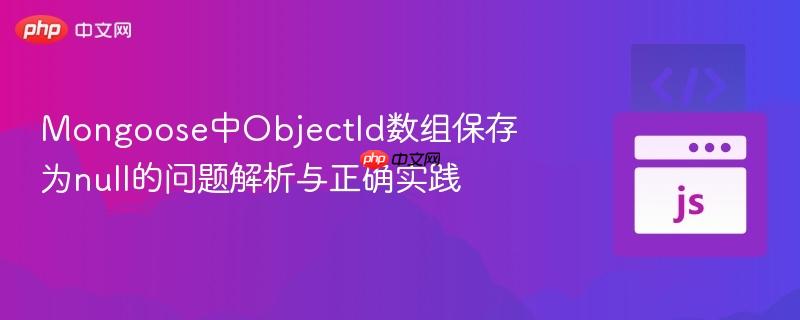
本文深入探讨了mongoose中将objectid数组保存到数据库时常见的`null`值问题。通过分析错误的mongoose schema定义,我们揭示了为何用户id未能正确存储,并提供了正确的schema定义方式。教程还包括api层面的代码示例、最佳实践和调试技巧,旨在帮助开发者避免此类数据存储陷阱,确保数据完整性。
在使用MERN堆栈开发应用时,Mongoose作为MongoDB的对象数据模型(ODM),极大地简化了数据操作。然而,在定义Schema时,如果对数组类型的字段,尤其是包含引用类型(如mongoose.Schema.Types.ObjectId)的数组,处理不当,可能会导致数据存储异常,例如,本应存储用户ID的数组字段最终却显示为null值。
开发者在使用Mongoose定义了一个会话(Conversation)模型,其中members字段旨在存储参与会话的两个用户的ID。API调用成功,并返回“created successfully”的消息。然而,在MongoDB数据库中检查时,members数组中存储的却是两个null值,而非预期的用户ID。
原始(错误)的Schema定义示例:
const mongoose = require("mongoose");
const conversationSchema = mongoose.Schema({
members:[ { // 注意这里的定义方式
type: mongoose.Schema.Types.ObjectId,
ref: "User",
}],
});
const conversation = mongoose.model("conversation", conversationSchema);
module.exports = conversation;对应的API处理逻辑:
app.post("/api/conversation",async(req,res)=>{
try {
const {sid,rid} =req.body; // sid 和 rid 预期是用户ID字符串
const newConversation = new Conversation({ members:[sid,rid]}); // 将ID直接作为数组元素传入
await newConversation.save()
res.status(200).send("created sucessfully")
} catch (error) {
console.log(error)
}
})问题出在members字段的Schema定义上。当members被定义为[{ type: mongoose.Schema.Types.ObjectId, ref: "User" }]时,Mongoose期望members是一个数组,并且数组的每个元素都是一个对象,这个对象需要包含type和ref属性(尽管ref通常是Mongoose内部处理的,但Mongoose会尝试匹配结构)。然而,在API中,我们直接传入了[sid, rid],其中sid和rid是字符串形式的ObjectId。Mongoose在尝试将这些字符串强制转换为期望的对象结构时,由于无法找到匹配的内部字段(如type),最终导致存储为null。
要正确地定义一个存储ObjectId数组的字段,应明确指出该数组的元素类型是ObjectId。ref属性则应用于数组中的每个ObjectId,表明它们引用的是哪个模型。
正确的Schema定义示例:
const mongoose = require("mongoose");
const conversationSchema = mongoose.Schema({
members: { // 注意这里的定义方式,直接指定数组的类型
type: [mongoose.Schema.Types.ObjectId], // 表示这是一个ObjectId类型的数组
ref: "User", // 数组中的每个ObjectId都引用User模型
},
});
const conversation = mongoose.model("conversation", conversationSchema);
module.exports = conversation;通过将type属性设置为[mongoose.Schema.Types.ObjectId],我们明确告诉Mongoose,members字段是一个由ObjectId组成的数组。这样,当传入[sid, rid]时,Mongoose能够正确地识别并存储这些ObjectId。
尽管Schema的修正解决了核心问题,但在API层面,我们仍可以采取一些最佳实践来增强健壮性:
优化后的API处理逻辑示例:
const mongoose = require("mongoose"); // 确保Mongoose已导入,用于ObjectId验证
app.post("/api/conversation", async (req, res) => {
try {
const { sid, rid } = req.body;
// 1. 输入验证:确保传入的ID是有效的ObjectId
if (!mongoose.Types.ObjectId.isValid(sid) || !mongoose.Types.ObjectId.isValid(rid)) {
return res.status(400).send("Invalid user IDs provided.");
}
// 使用正确的Schema定义,这里的操作将按预期工作
const newConversation = new Conversation({ members: [sid, rid] });
await newConversation.save();
res.status(200).send("Conversation created successfully.");
} catch (error) {
console.error("Error creating conversation:", error); // 使用console.error记录错误
// 2. 错误处理:向客户端发送更具体的错误信息
res.status(500).send("Failed to create conversation due to an internal server error.");
}
});通过理解Mongoose Schema定义的细微差别并遵循最佳实践,开发者可以有效避免数据存储问题,确保应用程序的数据完整性和可靠性。
以上就是Mongoose中ObjectId数组保存为null的问题解析与正确实践的详细内容,更多请关注php中文网其它相关文章!

每个人都需要一台速度更快、更稳定的 PC。随着时间的推移,垃圾文件、旧注册表数据和不必要的后台进程会占用资源并降低性能。幸运的是,许多工具可以让 Windows 保持平稳运行。

Copyright 2014-2025 https://www.php.cn/ All Rights Reserved | php.cn | 湘ICP备2023035733号